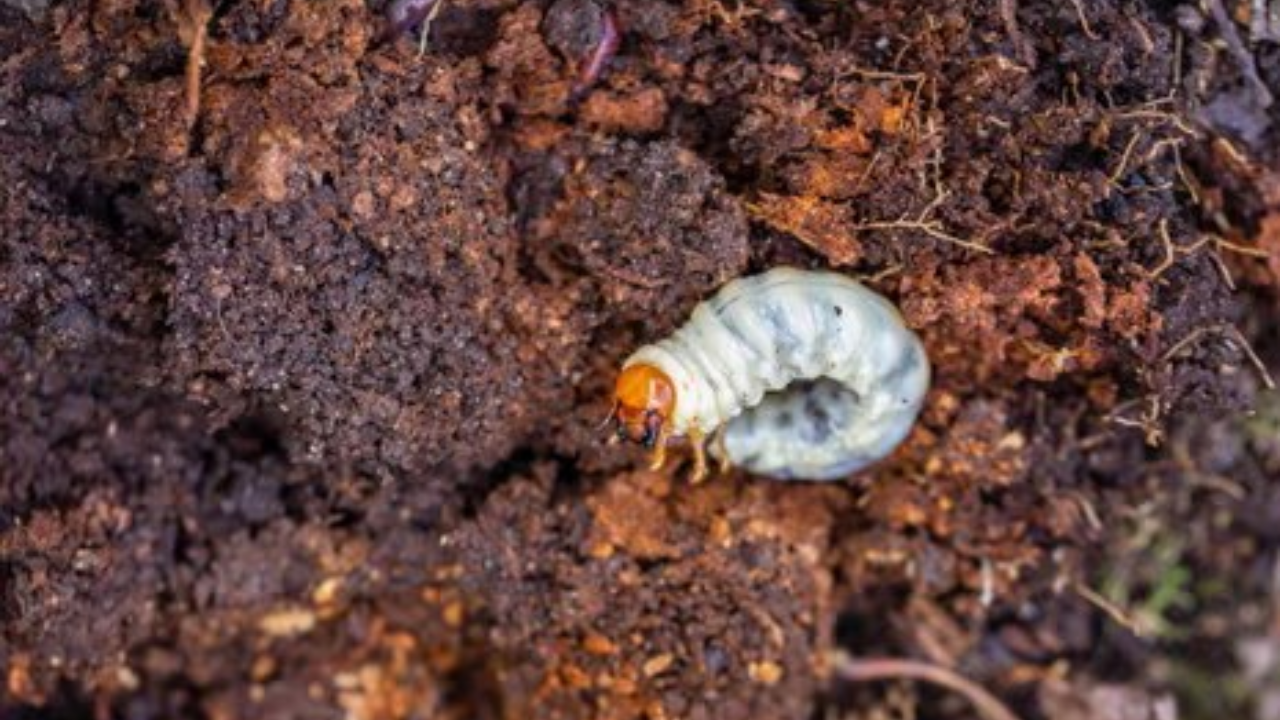A lawn worm refers to the immature stage of certain insects, primarily beetle larvae, known as grubs that feed on grass roots. These grubs can cause significant damage to lawns by destroying the root system.
Crafting an ideal lawn requires understanding the creatures that inhabit it, including lawn worms. Gardeners and homeowners often encounter these worm-like larvae, which can either benefit or harm their green spaces. Originating from the eggs of beetles, such as the June bug, these grubs live just beneath the soil’s surface.
They feast on the roots of grass, potentially leading to yellow patches and a spongy feel underfoot—a clear sign of infestation. Conversely, earthworms, while also found in lawns, play a vital role in soil aeration and nutrient recycling. Knowing the difference is essential for effective lawn care and maintenance, ensuring that beneficial worms thrive while harmful grubs are managed. Proper lawn care techniques, such as aeration and timely watering, can help maintain a balanced ecosystem in your yard.

Lawn Worms Unearthed
Curious critters burrow beneath our lawns, silently shaping the subsurface world.
Often escaping the notice of homeowners, these lawn worms are more than just wriggling inhabitants;
they are vital players in the ecosystem of our gardens.
Meet The Subterranean Lawn Dwellers
Lawn worms belong to diverse battalions of soil-dwelling organisms. Earthworms, for example,
are beneficial aerators. They work tirelessly to break down organic matter, craft rich soil structures, and pave the way for
nutrient absorption. Grub worms, the larvae of beetles, feed on grass roots and can be lawn pests.
| Type of Lawn Worm | Role in the Lawn |
|---|---|
| Earthworms | Soil aeration and composting |
| Grub worms | Root consumption; potential lawn damage |
From Larvae To Lawn Invaders
Grub worms are not born as lawn invaders. Adult beetles lay eggs in the soil during the summer months.
The eggs hatch into larvae, which eagerly munch on grassroots. Recognizing the signs early can prevent extensive damage.
- Irregular brown patches on the lawn indicate grub presence.
- Increased bird activity may reveal a grub-rich feeding area.
- Soft, spongy turf can signal subsurface feeding by larvae.
Addressing a grub worm problem involves lawn care practices such as proper mowing, watering, and natural predator support.
Biological control measures, like introducing beneficial nematodes, can effectively manage grub populations.

Ecological Impact
Lawn worms play a significant role in the ecosystem. These creatures can influence overall yard health. In this discussion on their ecological impact, we’ll see how they affect soil and grass.
Soil Aeration And Grass Health
Lawn worms enhance soil structure and quality. They do this through their movement and feeding habits within the ground. This section will examine their contribution to soil aeration and grass health.
- Tunneling: Worms create tunnels in the soil. These allow air and water to flow better.
- Nutrient Cycling: Their waste, or castings, enriches the soil with nutrients.
- Root Growth: The tunnels also enable grass roots to expand easily, leading to healthier lawns.
The Great Debate: Friend or Foe?
The Great Debate: Friend Or Foe?
Are lawn worms allies or adversaries? This heated debate often swings between the damage worms can cause and the benefits they offer.
| Pros of Lawn Worms | Cons of Lawn Worms |
|---|---|
|
|
In well-balanced ecosystems, worms are beneficial. However, excessive numbers might lead to problems, like attracting moles. It’s crucial to maintain a healthy balance in the soil for lawns to thrive.
Identifying Worm Infestation
Worms are vital for a healthy lawn, but too many can cause problems. It’s important to spot an infestation early. Let’s learn how.
Spotting The Signs
Visible worm castings often indicate worms are present. These small, mud-like piles on the lawn surface are worm waste. If you see more than usual, it might be an infestation.
- Excessive birds on your lawn might be feeding on a high number of worms.
- Soft ground can be a sign that worms have been over-aerating the soil.
- Bare patches in your lawn might show where worms have damaged the grassroots.
When Worms Overstay Their Welcome
Identifying a surplus of worms in your lawn is crucial for maintaining its health.
| Condition | Infestation Level |
|---|---|
| Muddy Lawn | High worm activity, especially after rain. |
| Grass Health | Deteriorating grass may suggest too many worms. |
Monitor these signs and act fast if worms start to harm your lawn.
The Mysterious Giant Lawn Worm
Imagine a worm so large it could be mistaken for a small snake. This is the concept behind the mysterious giant lawn worm — a creature discussed in hushed tones among gardeners and outdoor enthusiasts. It’s a topic that invites both curiosity and debate and taps into the universal human fascination with the extraordinary.
Separating Fact From Fiction
When it comes to the giant lawn worm, it’s important to distinguish science from folklore. Anecdotes and sightings often circulate on social media, creating a modern-day myth. Yet, these stories tend to lack scientific evidence. The reality? While worms can be sizeable creatures, the idea of an immense worm lurking in our lawns is not supported by entomological research.
Record-breaking Worms: Myth Vs Reality
In searching for truth, one may encounter claims of worms that stretch to impossible lengths. Let’s consider the facts:
| Claim | Truth |
|---|---|
| Giant worms spanning several feet | Most common lawn worms are a few inches long |
| Worms large enough to damage property | Typical worms benefit soil health and do not cause such harm |
In summary, while record-breaking sizes for some earthworm species are documented, the ‘giant lawn worm’ remains a figure of mythology. True lawn worms are beneficial, albeit smaller, denizens of our gardens and grassy areas.
Managing Lawn Worm Populations
Managing Lawn Worm Populations is critical for garden health. These creatures, often seen as garden allies, can sometimes become a nuisance. While earthworms improve soil structure and fertility, excess worm activity can lead to unsightly lawns. Management strategies should balance ecological benefits with aesthetic concerns.
Natural Predators And Prevention
A balanced ecosystem includes natural predators that help control worm populations. Birds, moles, and beetles feast on worms, providing natural control.
- Birds: Encourage birds in your yard with feeders and nesting boxes.
- Moles: While often viewed negatively, moles can regulate worm numbers.
- Beetles: Ground beetles and rove beetles are natural worm predators.
Preventative measures include maintaining soil pH and avoiding excessive organic matter on the soil surface.
Effective Strategies For Control
To mitigate excessive lawn worm populations, implement a multi-faceted approach:
- Aerate the soil to disrupt worm activity and improve lawn health.
- Reduce watering in the evening as wet conditions attract worms.
- Balance fertilizer applications, especially nitrogen-rich fertilizers, which can boost worm populations.
Chemical controls are an option but should be a last resort due to potential environmental harm.
| Method | Effectiveness |
|---|---|
| Aeration | High |
| Watering Practices | Moderate |
| Fertilization | Variable |
| Chemical Controls | High (but risky) |
Choose methods that align with your garden’s ethos and the local ecosystem.

Lawn Worm Diversity
The world beneath our feet teems with life, especially in the rich soil of our lawns.
A diverse range of lawn worms call this environment home, each playing a critical role in soil health and lawn aesthetics.
From beneficial earthworms to destructive grubs, the variety of species can be astonishing.
Understanding this diversity is key to maintaining a healthy, vibrant lawn.
The Various Species Beneath Our Feet
In the lush, green carpets of our yards, numerous species of worms flourish.
Earthworms, easily recognized by their long, segmented bodies, are gardeners’ favorites.
They break down organic matter and improve soil structure.
Meanwhile, nematodes, often microscopic, serve by controlling lawn pests.
Grubs, the larvae of beetles, can be detrimental, munching on grassroots.
- Earthworms: Aerate the soil and enhance fertility.
- Nematodes: Natural pest control agents.
- Grubs: Potential threats to lawn health.
Infamous Grass Cutters: Moth Larvae At Work
Among the diverse group of lawn worms, moth larvae warrant special attention.
Known colloquially as “cutworms”, these caterpillars feed at night.
They slice through grass stems at the soil line, leaving behind unsightly patches.
Vigilance and timely intervention are crucial to protect lawns from extensive damage.
| Moth Larvae Type | Appearance | Impact on Lawn |
|---|---|---|
| Black Cutworm | Dark, greasy-looking caterpillars | Severe cutting of grass blades |
| Bronze Cutworm | Large, bronze-colored worms | Irregular patches of damaged grass |
| Variegated Cutworm | Light brown with a spotted back | Clipping off seedlings and young plants |
FAQs Of What Is A Lawn Worm
Where Do Lawn Worms Come From?
Lawn worms, primarily earthworms, originate from the soil where they naturally exist and play a crucial role in enriching and aerating the soil, benefitting lawn health.
Are Worms In Lawn Good Or Bad?
Worms in lawns are generally beneficial as they naturally aerate the soil and improve nutrient distribution.
What Is The Biggest Lawn Worm Recorded?
The biggest lawn worm recorded is the African giant earthworm, reaching up to 6. 7 meters in length.
How Do You Get Rid of Worms In Your Lawn?
To get rid of lawn worms, apply natural pesticides or nematodes, ensure proper lawn aeration, avoid overwatering, and maintain healthy grass.
Conclusion
Understanding lawn worms is key to maintaining a healthy garden. These small creatures can greatly influence your yard’s ecosystem. Remember, not all worms harm your lawn; some are beneficial. Proper lawn care, including aeration and balanced watering, can manage and prevent damage.
By staying informed and vigilant, you’ll ensure your lawn remains a vibrant, worm-friendly environment. Keep nurturing your garden, and it will thrive!

Welcome to girlsbar-berryhome.com, where style meets home. Arafat Hossain, a passionate design enthusiast with a keen eye for trends and quality, founded you. Our curated collections reflect a commitment to elevating your living spaces. Explore a world of timeless elegance and modern flair with girlsbar-berryhome.com. Redefine your home, one carefully selected piece at a time.

